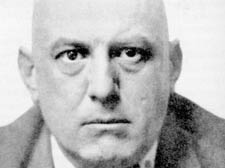|
|
 |
| |

Aleister Crowley: the morbid 'great beast' |
Is there no end to the vortex of decadence?
As he reads of London’s history of depravity and violence, Gerald Isaaman can’t help but think of the present-day capital
Order this book
WE live in decadent days. Or do we?
*
If decadence is defined as a lowering of morality or civilised culture, then, undoubtedly, the Bible and the Qur’an too have lost their true force, as suicide bombers blow themselves – and others – to smithereens.
And with children being smuggled into the country for people’s horrendous sexual gratification, cannabis grown in enormous quantities, possibly in a house next door to you, drugs galore sold on the streets, teenagers knifed and householders killed by marauding, booze-bingeing gangs, then is it any wonder that governments, let alone any religion, can no longer adequately cope?
Yet wasn’t it ever thus? Hasn’t society always over-indulged, been at the rough, raw edge of the way we live, trying to avoid its perils being the first lesson of street cred that today’s youngsters have to learn?
Certainly that seems the case when you dive into Decadent London, an awful yet fascinating encyclopedia of the worst manifestations of the last decade of the 19th century.
It truly digs the dirt with hair-raising stories set against hypocritical Victorian decency and the explosion of artistic genius such as Oscar Wilde, who suffered Reading gaol for his homosexuality.
What was then seen as outrageous and unacceptable is today viewed as art that broke down barriers and ordinary people escaping the awfulness of rat-infested homes. Yet author Antony Clayton muddies the water somewhat by finding if difficult to define exactly the decadence – or was it just the fashionable word of the moment? – he exposes.
The austere artist Aubrey Beardsley, just 19, lived in a house in Pimlico where, according to the artist William Rothenstein, “the walls were distempered a violent orange, and doors and skirtings were painted black – a strange taste, I thought, but his taste was all for the bizarre and exotic.”
One inspiration for Clayton’s thesis may well come from the fact that decadence was seen as “a new and beautiful and interesting disease” that saw the publication of Paul Verlaine’s The Decadent Movement in Literature.
Yet, on another plane, decadence, for him, includes the evil of Aleister Crowley, the morbid “great beast” who more than dabbled in drugs and the occult. His home at one time was a flat at 67/69 Chancery Lane, in the heart of Holborn, where he fitted out two rooms as temples, one all white, the other black.
Six mirrors, measuring six by eight feet, intended to deflect the energy of any magical force and retain it inside the room, dominated the white room, while the black room was a cupboard-sized space containing a small altar in the shape of a negro standing on his hands.
The central feature of this room was a human skeleton which Crowley “fed” with small birds and blood in a bid to bring it to life. His experiment, naturally, failed. But both rooms had a magic circle and pentagram drawn on the floor, as Crowley wavered between white and black magic.
No doubt there are still crazy places where crazy things happen, all fed, alas, by a decadent media that have literally brainwashed generations of children into believing that violence has some kind of justification, enjoyable in the form of some sick computer game or film.
Indeed, as Sir David Attenborough has pointed out, he was at the BBC when the “F-word” was used for the first time on TV, the result being that it is now commonplace parlance on the box, inevitably diminishing its original shockability.
Looking at Decadent London through the historical microscope – and Clayton’s ability to dredge up the grim facts is undoubtedly remarkable – makes you realise, uncomfortably, how close we have always been to the vortex of violence and animal-like indulgence in rape and revenge.
It is interesting how each new discovery lowers the tone. Clayton reveals that the music-hall, which we now view with tearful nostalgia, expanded because it was a means of ripping off the working-class with cheap liquor and food while the “entertainment” came virtually free.
Max Beerbohm, who admitted a crush on a 15-year-old performer, believed that the “aim of the music hall was, in fact, to cheer the lower classes up by showing them a life uglier and more sordid than their own”.
Did that inspire Walter Sickert to paint the Old Bedford music hall in Camden Town and the dead victims of the Camden Town murders, seen then as sensationalism yet today as masterpieces of devastating social art?
The cinema has followed in its wake. And from that has come mass pornography, as well as brilliant art.
Will the circle of decadence inevitably put us into a coma, as we wait for the end of mankind through global pollution? Or will some new saviour appear? I don’t think I’ll stick around that long.
 |
 |
|
 |
 |
|
 |
|